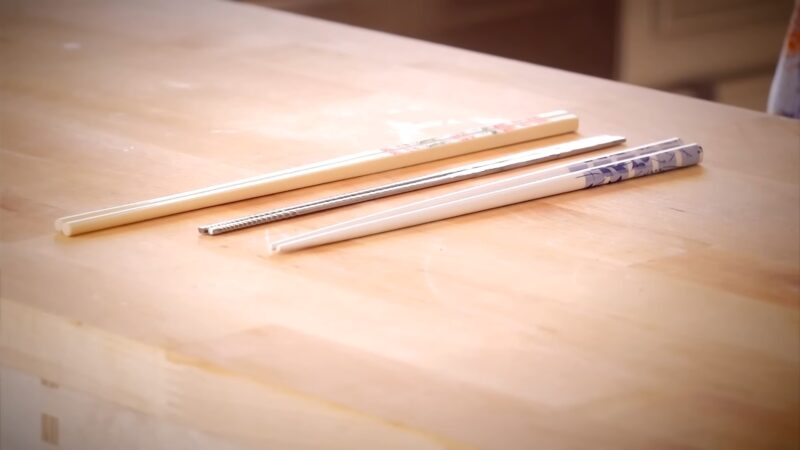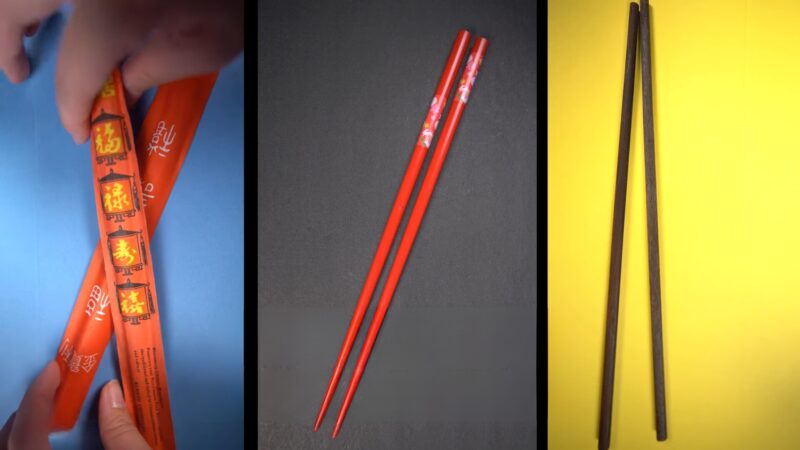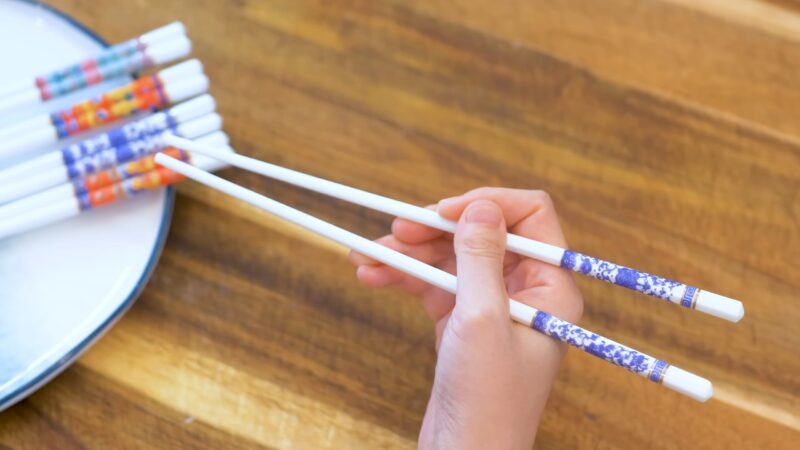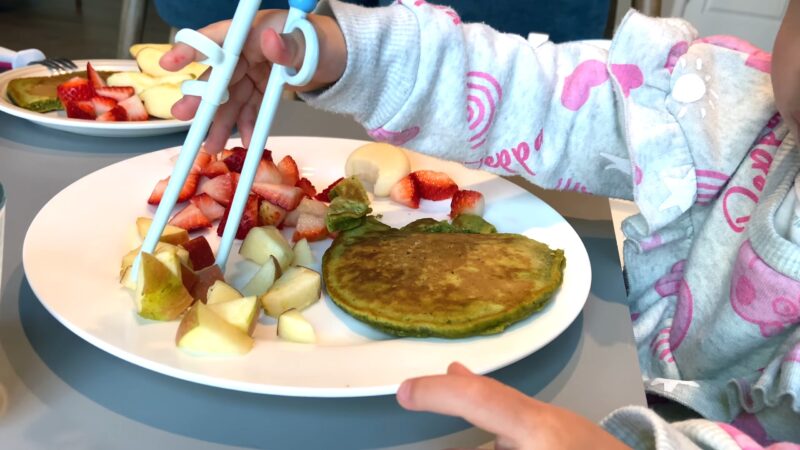Introducing kids to the world of chopsticks can be a fun and educational experience. As a parent, you have the unique opportunity to teach them a skill that’s not only useful at the dinner table but also opens a window to learning about different cultures. It’s about more than just eating; it’s about coordination, patience, and cultural appreciation.
This guide will walk you through the steps to make teaching your kids to use chopsticks an enjoyable and rewarding experience for both of you.
Choosing the Right Chopsticks
Materials and Types

Chopsticks come in a variety of materials, including bamboo, wood, metal, and plastic, each offering different benefits and drawbacks. For beginners, especially kids, bamboo or wooden chopsticks are often recommended due to their lightweight nature and non-slip surfaces, which make them easier to handle and manipulate.
The choice of material can also be a great conversation starter about sustainability and the environmental impact of different materials.
Size Matters

Selecting chopsticks that are the right size and length for your child’s hands is crucial for their success and comfort. Child-specific chopsticks are shorter, lighter, and often feature engaging designs or characters to make the learning process more enjoyable.
It’s important to consider the hand size and strength of your child to ensure they are not struggling with chopsticks that are too long or too heavy.
Training Chopsticks
For absolute beginners, training chopsticks can be an excellent option. These are often connected at the top, making them easier to handle and manipulate for small hands. Some models come with finger placement guides or fun characters that rest on the hand, making the learning process more intuitive and engaging for children.
Step-by-Step Guidance
Start by demonstrating the grip yourself, then guide their hands into the correct position. It’s crucial to correct their grip gently and encourage them to keep trying, even if they don’t get it right away.
Using visual aids, like diagrams or videos, can be helpful in showing the correct technique, and hands-on guidance can make a significant difference in their understanding and execution of the grip.
The Standard Grip

The standard grip, while simple for adults, can be a challenge for kids to master. The lower chopstick should rest on the ring finger and be supported by the thumb, creating a stable base, while the upper chopstick is maneuvered by the thumb, index, and middle fingers.
This grip is akin to holding a pencil, but requires a bit more coordination and finesse, making it an excellent exercise for developing fine motor skills.
Practice Makes Perfect

In the beginning, children might find the grip awkward or challenging, and it’s common for them to struggle with coordination and control. Encourage them to practice with fun activities, like picking up small objects or playing simple games, before moving on to using chopsticks with food.
Patience and consistent practice are key in this learning phase, and it’s important to make the experience as stress-free and enjoyable as possible.
Advanced Techniques
Once your child has a comfortable grasp of the basic technique, it’s time to focus on refining their precision with chopsticks. Start by teaching them how to pick up various sizes and textures of food, beginning with larger, easy-to-grasp items before progressing to smaller, more challenging ones like slippery noodles or grains of rice.
This step is crucial in helping them understand the adaptability and precision required when using chopsticks, enhancing their dexterity and control.
Eating Different Foods
Different foods require distinct techniques when using chopsticks. For example, rice, often perceived as tricky due to its small size, is usually scooped and lifted rather than pinched. Demonstrate these techniques and explain the nuances involved in handling different types of food.
This not only teaches them the practical use of chopsticks but also enriches their understanding and appreciation for various Asian culinary traditions.
Speed and Efficiency
As your child becomes more adept at using chopsticks, encourage them to use them more frequently, even with non-traditional foods. With regular practice, their speed and efficiency will naturally increase.
However, it’s important to remind them that eating slowly is also a part of mindful eating, which chopsticks can inherently promote. This balance between skillfulness and mindfulness is a valuable aspect of eating with chopsticks.
Practice Through Fun Activities
Incorporate games and playful challenges into chopstick practice to make it more engaging. Activities like transferring small objects such as beads or marbles from one bowl to another, or timing how fast they can pick up a certain number of items, can turn practice into an exciting game.
These games not only improve their chopstick skills but also add an element of fun and competition, which can be highly motivating for children.
Crafts with Chopsticks
Using chopsticks for crafts is another creative way to practice. Engage your child in building structures or creating art projects using chopsticks.
This not only helps improve their dexterity but also sparks their creativity and imagination, showing them that chopsticks aren’t just for eating but can be a versatile tool in various activities.
Cultural Exploration

Extend the chopstick learning experience beyond the dining table by exploring the cultures where chopsticks are commonly used. Engage your child in watching cultural movies, reading books, or even preparing and trying out recipes from these cultures.
This holistic approach not only makes learning to use chopsticks more interesting but also provides a broader perspective on the significance of chopsticks in different cultural contexts.
Tips for Parents and Guardians
- Learning to use chopsticks can be a challenging process for children, so it’s crucial for parents and guardians to be patient and provide continuous encouragement.
- Recognize and celebrate their small victories, and remind them that it’s okay to make mistakes and take time to learn. This positive reinforcement can significantly boost their confidence and willingness to keep practicing.
- Children often imitate the actions of adults, so using chopsticks yourself can be a powerful way to motivate them. Show your enthusiasm for this skill by integrating chopsticks into your regular meals. Your interest and effort in using chopsticks can serve as a great example and inspire your child to keep trying and improving.
Cultural Sensitivity
While teaching your child to use chopsticks, it’s essential to instill a sense of respect and sensitivity towards the cultures associated with them. Explain the significance of chopsticks in different Asian cultures and the importance of respecting these traditions.
This approach not only teaches them a new skill but also fosters cultural awareness and appreciation, which is vital in today’s globalized world.
FAQs
At what age should I start teaching my child to use chopsticks?
It’s generally recommended to start teaching kids to use chopsticks around the age of 3 to 5 years. At this age, children usually have developed enough fine motor skills to handle chopsticks with training models. However, every child is different, so consider their individual readiness and interest.
My child is left-handed. Should I teach them differently?
Left-handed children can use chopsticks in the same way as right-handed children, but it might be helpful to have a left-handed role model demonstrate the technique. Ensure that the ones you choose are symmetrical so they can be used comfortably on either hand.
How long does it typically take for a child to learn to use chopsticks proficiently?
The time it takes for a child to become proficient with chopsticks varies greatly. Some children may pick it up in a few weeks, while others might take several months. Consistent practice and positive reinforcement are key factors in speeding up the learning process.
Are there any specific foods that can make learning chopsticks easier for kids?
Yes, starting with larger and stickier foods can make it easier for kids to learn. Foods like large pieces of fruit, sushi rolls, or sticky rice are good options. These foods are easier to pick up and hold, providing a confidence boost to young learners.
Can using chopsticks help with a child’s academic skills?
While using chopsticks primarily enhances fine motor skills and hand-eye coordination, these improvements can indirectly benefit academic skills such as handwriting and art. The dexterity and concentration required can transfer to other areas requiring fine motor control.
What should I do if my child gets frustrated while learning?
If your child is getting frustrated, take a break from the practice and revisit it later. It’s important to keep the learning experience positive and stress-free. You can also try making the practice more game-like or rewarding to maintain their interest and motivation. Remember, patience and encouragement are key.
Final Thoughts
To conclude, teaching kids how to use chopsticks is a simple yet valuable experience. It’s about helping them learn a new skill, being patient, and having fun together. It’s okay if they don’t get it right away, what matters most is the time you spend together and the little steps they take in learning something new.
Keep it light, encouraging, and enjoyable, and you’ll both do great!
